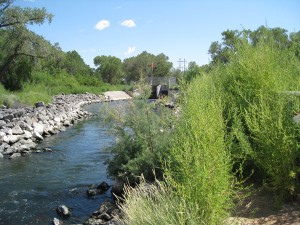Out here in the inland arid western United States, water management is complicated by the convoluted question of what happens to the water after we “use” it.
Sometimes it’s used up. Sometimes we put it back, in a way that allows others to use it.

Largest Tributary on the Middle Rio Grande
Regular Inkstain readers, all three of you, will recognize this theme from a riff a few weeks back on my visit to Albuquerque’s sewage treatment plant. With some thematic tweaks, I turned it into a newspaper column (sub/ad req):
A groundbreaking last week at the sewage treatment plant illustrates the issue. Dignitaries did the traditional shovel-in-dirt ritual to ceremonially launch construction of a treatment plant that will add an extra level of cleaning to about 5 percent of the wastewater now going into the Rio Grande. Instead of sending it to the river, it will be pumped into a newly built network of pipes to irrigate parks on Albuquerque’s south side.
In other words, instead of returning it to the system, it will be consumptively used. We’ll be able to reduce our groundwater pumping or river diversions by a like amount, but it’s not like we’re getting free water here. In terms of the overall amount of water in the system, the net effect is essentially zero.

It seems not quite right to say the net effect is zero.
On the plus side, you’ve already noted that recycled water would go for landscape irrigation, so there’s a quantifiable amount of real potable water conserved and available for other uses.
Since your treated wastewater otherwise gets discarded to the Rio Grande never to be used by ABQ again, the recycled water really should be counted as new water for ABQ.
Also, a small amount of irrigation water will percolate into groundwater, permitting yet another reuse opportunity.
On the negative side, whatever you recycle reduces your contribution to the Rio Grande and any downstream use of that water.
That’s one difference between recycling in ABQ and recycling here in San Diego: SD has no downstream users that might complain about reduced flows.
George – Thanks for dropping by, and for triggering the column in the first place.
A couple of points:
Re landscape water percolating into the groundwater, here in Albuquerque that’s negligible other than in a few neighborhoods (though I should have made that clear in the column). Depth to groundwater across most of city is such that the recharge is zero.
As for whether the water can be counted as “new water for ABQ,” that’s maddeningly unclear at this point. The state’s water accounting system requires ABQ to offset the effects of its groundwater pumping through either return flows or buying up and retiring ag water rights. If we reduce our return flows, there is at least a chance that the State Engineer could require us to make up the difference by buying up and retiring more water rights. Or something. My comment about it being “maddening” is a reference to my inability thus far to get from the Water Utility the water accounting analysis that might shed some light on this question.